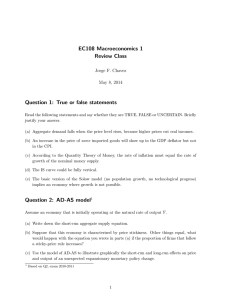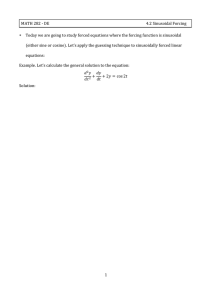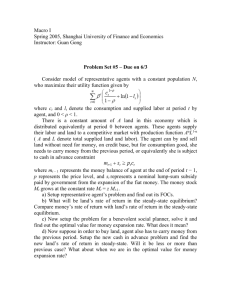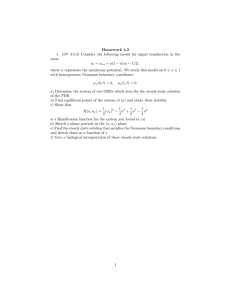EC108 Macroeconomics 1 Review Class - Suggested Answers Jorge F. Chavez
advertisement
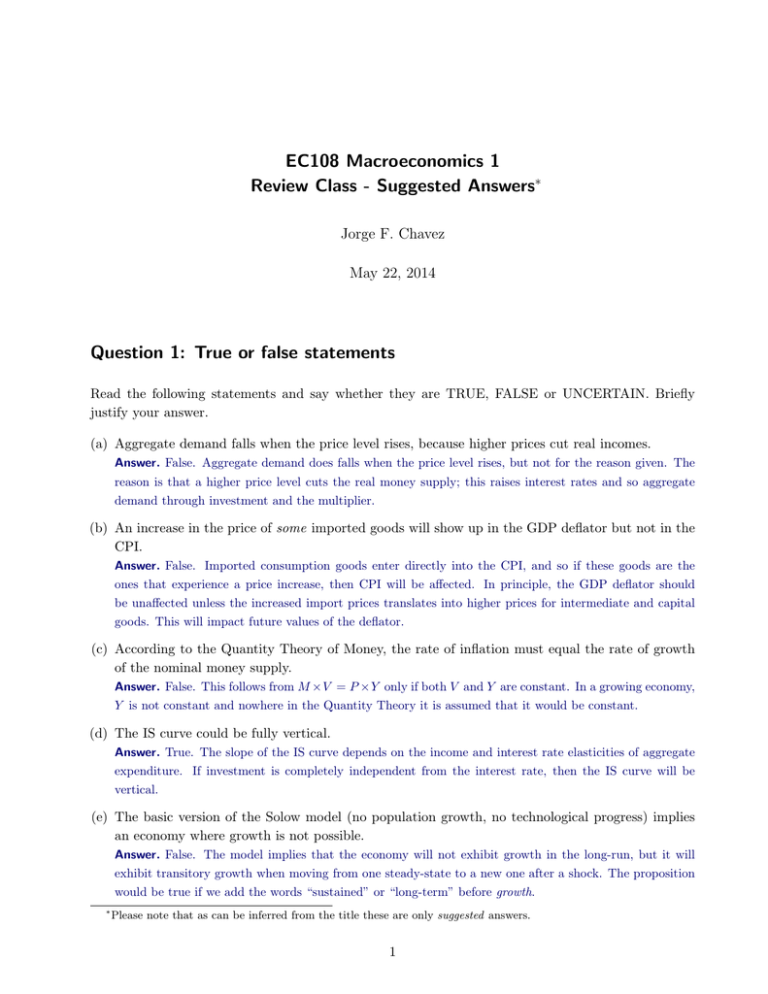
EC108 Macroeconomics 1 Review Class - Suggested Answers∗ Jorge F. Chavez May 22, 2014 Question 1: True or false statements Read the following statements and say whether they are TRUE, FALSE or UNCERTAIN. Briefly justify your answer. (a) Aggregate demand falls when the price level rises, because higher prices cut real incomes. Answer. False. Aggregate demand does falls when the price level rises, but not for the reason given. The reason is that a higher price level cuts the real money supply; this raises interest rates and so aggregate demand through investment and the multiplier. (b) An increase in the price of some imported goods will show up in the GDP deflator but not in the CPI. Answer. False. Imported consumption goods enter directly into the CPI, and so if these goods are the ones that experience a price increase, then CPI will be affected. In principle, the GDP deflator should be unaffected unless the increased import prices translates into higher prices for intermediate and capital goods. This will impact future values of the deflator. (c) According to the Quantity Theory of Money, the rate of inflation must equal the rate of growth of the nominal money supply. Answer. False. This follows from M ×V = P ×Y only if both V and Y are constant. In a growing economy, Y is not constant and nowhere in the Quantity Theory it is assumed that it would be constant. (d) The IS curve could be fully vertical. Answer. True. The slope of the IS curve depends on the income and interest rate elasticities of aggregate expenditure. If investment is completely independent from the interest rate, then the IS curve will be vertical. (e) The basic version of the Solow model (no population growth, no technological progress) implies an economy where growth is not possible. Answer. False. The model implies that the economy will not exhibit growth in the long-run, but it will exhibit transitory growth when moving from one steady-state to a new one after a shock. The proposition would be true if we add the words “sustained” or “long-term” before growth. ∗ Please note that as can be inferred from the title these are only suggested answers. 1 EC108 Review May 2014 Question 2: AD-AS model1 Assume an economy that is initially operating at the natural rate of output Ȳ . (a) Write down the short-run aggregate supply equation. Answer. Any of the three theories considered (sticky wages, sticky prices, and incomplete information) yield the following expression: Yt = Ȳ + α (Pt − Pte ) + ϵt where ϵt is a transitory shock. (b) Suppose that this economy is characterized by price stickiness. Other things equal, what would happen with the equation you wrote in parte (a) if the proportion of firms that follow a sticky-price rule increases? Answer. The aggregate supply equation relates deviations of GDP with respect to its potential level (Yt − Ȳ ) and deviations of the price level with respect to the expected price level (Pt − Pte ). The parameter α is related to how responsive is output to changes in prices. Therefore, other things being equal, if a greater proportion of firms follows the sticky-price rule, α decreases (AS curve become less responsive or flatter). In the extreme case in which prices become fully sticky, the SRAS curve becomes completely horizontal. (c) Use the model of AD-AS to illustrate graphically the short-run and long-run effects on price and output of an unexpected expansionary monetary policy change. Answer. This positive AD shock moves output above its natural rate and P above the level people had expected. Over time P e adjust upwards, the SRAS shifts up, and output returns to its natural level. Figure 1: Effects on P and Y of an unexpected expansionary monetary policy change LRAS SRAS2 P SRAS1 C P 3 = P3e P2 P2e = P1 = P1e B AD2 A AD1 Y3 = Y1 = Ȳ 1 Y2 Y Based on Q2, exam 2010-2011 Jorge F. Chávez 2 EC108 Review May 2014 Question 3: Unemployment dynamics2 Consider the simplest model of unemployment dynamics. Let Ut denote the number of unemployed workers at time t, and let s and f denote the job-separation rate and the job finding rate in this economy. Assume initially that the total size of labor force is constant (Lt−1 = Lt = Lt+1 = L, all t). (a) Interpret s and f in terms of probabilities. Answer. The job separation rate s is the probability that a worker will loose its job. The job finding rate f is the probability that a worker that is actively seeking for a job finds one. (b) Let µt denote the unemployment rate at time t. Show that the unemployment rate in steady-state will be a function of s and f only. Answer. Start from: Ut+1 = Ut + sEt − f Ut Replace Et = L − Ut and divide both sides by L to put everything in terms of unemployment rates. Rearranging we get: µt+1 = s + (1 − s − f ) µt In steady-state µ̄ = µt+1 = µt . Hence, solving for µ̄: µ̄ = s s+f (c) Suppose s = 0.03 (or 3 percent) and f = 0.7 (or 70 percent). Initially (at time t = 0), the unemployment rate is equal to µ0 = 0.08. Further assume that at time t = 200 (in the long run) this economy will experience a permanent shock on f such that from period t = 200 onwards, f = 0.4. Sketch the evolution of the unemployment rate over time in a simple graph (Hint: consider how would the path of µt would look in a graph with time in the horizontal axis, where t goes from 0 to 1000). Answer. With s = 0.03 and f = 0.7 the unemployment rate in steady-state will be 0.041. Hence, at time t = 0 we are above the steady-state and from our knowledge of how µt evolves over time we know that we will progressively tend towards the steady-state from above. This might not take too long, so by the time we are at t = 199 the economy is already in steady-state. Then, the permanent shock on f translates into an increase of the steady-state rate of unemployment to µ = 0.697 ≈ 0.07. This means that right after the shock, the economy is below the steady-state, and therefore the evolution of µt will be such that we will progressively converge to the new steady-state from below. See figure 2. (d) In macroeconomics it is always useful to express a dynamic variable (say xt ) in terms of deviations from its value in steady state: x̃t ≡ xt − x̄. Show that the deviation of the unemployment rate at t + 1 with respect to its steady-state value can be expressed as a linear function of the deviation of the unemployment rate at time t, that is µ̃t+1 = γ µ̃t . Hint: Try to express the γ parameter in terms of s and f . 2 Based on Problem Sets Jorge F. Chávez 3 EC108 Review May 2014 Figure 2: Path of µt µt 0.08 0.07 0.041 t=0 t = 200 t Answer. It is just a matter of playing with the expression we got above as follows: µt+1 − µ̄ = s + (1 − s − f ) (µt − µ̄) + (1 − s − f ) µt − µ̄ Note that besides putting µ̄ on both sides of the equality, I am adding and subtracting (1 − s − f )µ̄ from the RHS. Rearranging appropriately we get: µt+1 − µ̄ = (1 − s − f ) (µt − µ̄) Note that s − (s + f )µ̄ = 0 because of the formula for the natural rate of unemployment. Hence γ ≡ (1 − s − f ) < 1. Making sure that γ < 1 is very important for the stability of the path followed by µt , can you see why?. (Optional) Now suppose that the labor force grows at a rate n: Lt+1 = (1 + n)Lt all t. (e) Show that the unemployment rate in steady-state will be a function of s, f and n only. Answer. See handout posted here. (f) (Harder) Show that we can also write µ̃t+1 = ξ µ̃t . What is the relationship between ξ and γ? Answer. Follow similar steps as for the case of no population growth. At the end you will find that both parameters are exactly the same. Jorge F. Chávez 4 EC108 Review May 2014 Question 4: Solow’s Growth Model3 Consider how unemployment would affect the Solow growth model. Suppose that output is produced according to the following production function: Yt = Ktα [(1 − u) Lt ]1−α where Kt is the aggregate stock of capital, Lt is the labor force and u is the natural rate of unemployment. The national saving rate is s, the labor force grows at a rate n and capital depreciates at a rate δ. (a) Express output per worker yt = Yt /Lt as a function of capital per worker kt = Kt /Lt and the natural rate of unemployment u. Answer. Output per worker is obtained dividing total output by the number of workers: yt ≡ f (kt ) = Ktα [(1 − u) Lt ] Lt 1−α 1−α = ktα (1 − u) (b) Describe the steady state of this economy and find the golden-rule level of kt . What is the saving rate that allows the economy to reach the Golden Rule? Answer. The textbook states that the law of motion that governs the stock of capital per worker in the Solow model with population growth is: ∆kt+1 = sf (kt ) − (n + δ) kt Of course you may use it directly and define the steady-state as follows, however it would be infinitively better if you are able to arrive to this (or similar) expression from first principles.4 In any case, in steadystate ∆kt+1 = 0, then: 1−α sk α (1 − u) 3 4 = (n + δ) k Based on an exercise proposed in Mankiw’s textbook This implies defining the equation that describes aggregate capital accumulation Kt+1 = Kt + sYt − δKt and the divide both sides by population to put all variables in per-worker terms. However note that we need to divide by Lt+1 in the LHS and by Lt in the RHS, so we must do this carefully to preserve the equality. It turns out that the procedure is simple if we take into account that Lt+1 /Lt = 1 + n as follows: Kt+1 Lt+1 = sf (kt ) + (1 − δ) kt Lt+1 Lt Hence we can rewrite this as: kt+1 = sf (kt ) + (1 − δ) kt (1 + n) To define the steady-state we can either set kt+1 = kt = k and solve for k or we can defined ∆kt+1 = kt+1 − kt : ∆kt+1 ≡ kt+1 − kt = = sf (kt ) + (1 − δ) kt − (1 + n) kt (1 + n) sf (kt ) − (n + δ) kt (1 + n) Note that the numerator of the last equality is exactly the same expression stated by the textbook. Jorge F. Chávez 5 EC108 Review May 2014 where k denotes the value of kt in steady-state. Solving for k we get: ( k = (1 − u) s n+δ )1/(1−α) (1) Note that unemployment lower the marginal product of capital and hence reduces the amount of capital the economy can reproduce in steady-state. Note also that when u = 0 we are back to the textbook version of the model. The Golden Rule value of kt is the stock of capital per worker that maximizes consumption in steady-state. In this case, consumption in steady state is: c = f (k) − (n + δ)k where I am using (n+δ)k = sf (k). To find the stock of capital per worker that maximizes this consumption we can take a look at the FONC : ∂c = f ′ (k) − (n + δ) = 0 ∂k 1−α For y = ktα (1 − u) ( ) f ′ k GR k GR ⇒ ( ) f ′ k GR = n + δ we can get a closed form solution for k GR : ( )α−1 1−α = α k GR (1 − u) =n+δ ( )1/(1−α) α = (1 − u) n+δ (2) Comparing (2) with (1) we can see that the only way in which the economy can reach this Golden rule steady-state is by setting the saving rate equal to the elasticity of output with respect to capital (sGR = α). The concept of the Golden Rule for the case of the Solow model is illustrated in figure 3. There you can ( ) see three alternative saving rates, and you can visualize the Golden Rule condition f ′ k GR = n + δ: the slope of f (·) must be equal to the slope of the (n + δ)k line. (c) Is there any difference if we analyze output per effective worker instead of output per worker? Why? Answer. Even though before we made the analogy between the term (1 − u) and a technological shock, in reality because u is the natural rate of unemployment it is constant. Therefore setting the model in per-worker (dividing by L as we did) or in per-effective-worker terms (dividing by (1 − u)L) is irrelevant. In other words, unlike the model with labor-augmenting technological progress in which Yt /(Et Lt ) will become constant in the long-run (once the economy reaches a steady-state) (unlike Yt /Lt which will not be constant but growing), here both Yt /Lt and Yt /[(1 − u)Lt ] will be constant. (d) Suppose that some change in government policy reduces the natural rate of unemployment. Describe how this change affects output both immediately and over time. Is the steady-state effect on output larger or smaller than the immediate effect? Explain. Answer. If we lower the natural rate of unemployment from u1 to u2 , the steady-state capital stock per worker will be larger as seen in the last equation from part a. The steady-state level of income per worker will also be higher–both because of the rise in k* and the direct effect on the production function. The immediate effect will be a rise in output at the initial level of the capital stock, but no effect yet from a higher capital stock. Thus, the immediate effect on output is smaller than the steady-state effect. See figure 4. Jorge F. Chávez 6 EC108 Review May 2014 Figure 3: The Golden Rule f (k) (n + δ) k sf (k, u) c1 (n + δ)k cGR s1 f (k1∗ ) sGR f k s1 f (k) = (n + δ) GR c2 sGR f (k GR ) = (n + δ) s2 f (k) s2 f (k2∗ ) = (n + δ) k2 k GR k1 k Figure 4: Effect of reducing the natural rate of unemployment (n + δ) k (n + δ) k sf (k, u) sf (k, u2 ) sf (k1∗ , u2 ) = (n + δ) sf (k, u1 ) sf (k2∗ , u1 ) = (n + δ) k1∗ Jorge F. Chávez k2∗ k 7 EC108 Review May 2014 Question 5: Phillips curve Suppose that an economy has the following Phillips curve: πt = πte − 0.5(ut − 0.06) + vt (a) What is the natural rate of unemployment (un )? Answer. In steady-state, inflation will be equal to expected inflation (πt = πte ) and there will be no shocks (vt = 0). Hence un = 0.06. (b) Use the Phillips curve diagram to illustrate graphically how the inflation rate π and unemployment rate u change in the short run to an unexpected expansionary monetary policy. Answer. Because the shock is unexpected, expectations do not change and as such the Phillips curve does not change. The resulting outcome is a change along the Phillips curve. (c) Use the Phillips curve diagram to illustrate graphically how the inflation rate π and the unemployment rate u change in the short run to an expected expansionary monetary policy. Answer. Unlike the previous case, here expectations change and therefore the Phillips curve shifts upwards (because the shock came in the form of an expansionary monetary policy). Question 6: Dynamic AD-AS Model5 Consider a dynamic AD-AS model is characterized by the following equations: Yt = Ȳt − α (rt − ρ) + ϵt The demand for goods and services rt = it − Et πt+1 The Fisher equation ) ( πt = Et−1 πt + ϕ Yt − Ȳt + vt The Phillips curve Et πt+1 = πt Adaptative expectations ( ) it = πt + ρ + θπ (πt − πt∗ ) + θY Yt − Ȳt The Monetary-Policy rule (a) Write down the DAD and DAS curves and characterize the long-run equilibrium.6 Answer. To get the DAD begin with the demand for goods and services and replace the real interest rate using the Fisher equation. Then replace the nominal interest rate using the monetary-policy equation and the expected inflation. Rearranging terms you’ll get: ] [ ] [ 1 αθπ (πt − πt∗ ) + εt Yt = Ȳ − 1 + αθY 1 + αθY To get the DAS curve replace expectations in the Phillips curve and you are all set: ( ) πt = πt−1 + ϕ Yt − Ȳ + vt 5 6 Based on exercises proposed in Mankiw’s textbook That is, say what happens in the long-run once the economy reaches an equilibrium. Jorge F. Chávez 8 EC108 Review May 2014 (b) Suppose the economy is hit by a transitory supply shock vt > 0. Explain graphically how the economy returns to its short-run equilibrium. Answer. This situation is illustrated in figure 5. Start from full equilibrium (point A). The economy is hit by a transitory shock that will have effect only at time t. This is shown with a shift in the DAS curve from DASt−1 to DASt (the shift is by exactly the size of the shock). The supply shock causes inflation to rise and output to fall. Note that according to the model, part of the effects of this shock is transmitted to the economy through the reaction of monetary policy. The reason is the increase in inflation triggers the central bank’s response by raising nominal and real interest rates. The higher interest rate reduces demand of goods and service in the economy which keeps output below its natural level (point B). Slopes here matter because it can be seen in the graph that the jump in inflation is lower than the size of the shock. The reason for this is that the reduction in output dampens the inflationary pressure on the economy to some degree. The shock fades between t and t + 1 (the shock vt+1 = 0 again) but because expectations exhibit inertia, the economy is unable to return to its original equilibrium, but to an intermediate point (point C in figure 5). Figure 5: DAD/DAS - A transitory supply shock Ȳ π DASt DASt+1 πt B DASt−1 C πt+1 A πt−1 DADt−1 = DADt = DADt+1 Yt Yt+1 Yt−1 Y (c) The sacrifice ratio is the accumulated loss in output that results when the central bank lower its target for inflation by 1 percentage point. What is the sacrifice ratio implied by the dynamic AD-AS model?7 Answer. The sacrifice ratio measures the cost in terms of output associated with a one-percentage point reduction in the target (long-run) inflation rate. Hence we need to come up with a measure of the impact 7 Hint: You have to write down an expression for the sacrifice ratio in terms of model parameters. Jorge F. Chávez 9 EC108 Review May 2014 of πt∗ on Yt from the equations in the model. We can achieve this by replacing the DAS into the DAD: [ ] [ ] ( ( ) ) αθπ 1 ∗ Yt = Ȳ − πt−1 + φ Yt − Ȳ + υt − πt + εt 1 + αθY 1 + αθY Rearrange the terms so that we can separate Yt from πt∗ : [ ] [ ] [ ] ( ) αθπ αθπ 1 ∗ Yt = Ȳ − πt−1 − φȲ + υt − πt − φYt + εt 1 + αθY 1 + αθY 1 + αθY Finally, [ [ ] [ ] ] [ ] ( ) αθπ αθπ φ αθπ 1 πt−1 − φȲ + υt + 1+ Yt = Ȳ − πt∗ + εt 1 + αθY 1 + αθY 1 + αθY 1 + αθY Hence the implied sacrifice ratio is: αθ π ∂Y αθπ 1+αθY = = ∗ αθ φ π ∂πt 1 + αθY + αθπ φ 1 + 1+αθY Question 7: Deficit and Public Debt8 The government debt of Mediterranea stands at £12, 000, and the long term interest rate is 5 percent. The governments budget for this year is based on a proportional income tax rate of 20 percent. From the revenue the government must meet consumption spending commitments of £1, 000 as well as interest payments on the debt. The economy’s production possibilities are given by its natural rate of GDP, which is £6, 000. (a) What is the level of GDP at which the Mediterranean government will balance its budget this year (5 marks)? Answer. Recall that: ∆Dt+1 ≡ Dt+1 − Dt = Bt = Gt + it Dt − Tt Hence the level of nominal GDP that allows to balance the budget is: 0 = 1, 000 + 0.05 × 12, 000 − 0.20 × Y where the last term if Tt = τ Yt . Solving for Y we get, Y = 8000. (b) What is the structural deficit or surplus of the Mediterranean government (5 marks)? Answer. The structural deficit is the deficit that the economy will obtain if it is producing at its potential output level. Here potential output in nominal terms if Y P = 6000. Hence: Btstructural = 1, 000 + 0.05 × 12, 000 − 0.20 × 6000 = 400 8 Exam 2009/10 Jorge F. Chávez 10 EC108 Review May 2014 So, the economy is running a structural fiscal deficit (net increase in debt). (c) Given your answers to (a) and (b), explain what is likely to happen in the Mediterranean economy over the next years on the assumption that the economy has an IS-LM structure and policies remain unchanged (10 marks). Answer. Since the economy has a structural deficit, debt accumulation might accelerate in future periods. If this happens, two effects will take place. First, because debt service payments are received by domestic households, higher public debt will move the IS curve upwards because the increase in family incomes. This is inflationary. Second, the LM curve will tend to shift as well because of the growing liquidity preference as the stock of debt increases. This is a deflationary effect. If debt continues to rise, the country might eventually face a huge probability of default. That means that a crisis might be ad portas. (d) How might your answer change if it turned out that Mediterranean households adhere to a Ricardian view of government borrowing (that it is equivalent to taxation) (5 marks)? Answer. If households are Ricardian, then the inflationary effect described before will not take place (the IS curve will not shift). Households will reduce consumption because they expect future tax increases to finance the increasing debt. Jorge F. Chávez 11

